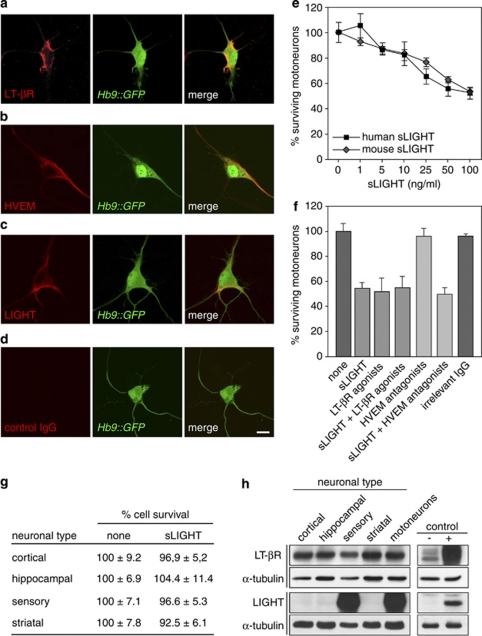Figure 1.
sLIGHT selectively induces death of motoneurons. (a–d) Hb9∷GFP motoneurons were cultured for 24 h and immunostained with anti-LT-βR (a), anti-HVEM (b) and anti-LIGHT (c) antibodies. Goat (d) or rabbit (not shown) irrelevant IgGs were used as control. Scale bar, 10 μm. (e) Mouse motoneurons were cultured for 24 h and then incubated with increasing concentrations of human or mouse sLIGHT. Motoneuron survival was determined 48 h later and expressed relative to non-treated cells. Henceforth, sLIGHT will refer to the human form of the recombinant protein. The distance between the x-axis values is arbitrary. (f) After 24 h in culture, motoneurons were treated (or not) with agonistic anti-LT-βR antibodies (100 ng/ml), antagonistic anti-HVEM antibodies (100 ng/ml) or irrelevant goat IgG (100 ng/ml) in combination (or not) with sLIGHT (100 ng/ml). Cell survival was determined 48 h later. (g) Twenty four hours after plating, cortical, hippocampal, sensory and striatal neurons were treated (or not) with sLIGHT (100 ng/ml). Neuron survival was determined 48 h later. (h) Protein extracts from cortical, hippocampal, sensory, striatal and motoneurons cultured for 24 h were resolved by sodium dodecyl sulfate polyacrylamide gel electrophoresis, followed by Western blotting with specific antibodies to LT-βR and LIGHT. The loading control was α-tubulin. Lysates from Cos-7 cells transfected (+) or not (−) with LT-βR or LIGHT expression vectors were used as controls. Graphs in (e), (f) and table in (g) show means values of three independent experiments, each done in triplicate

